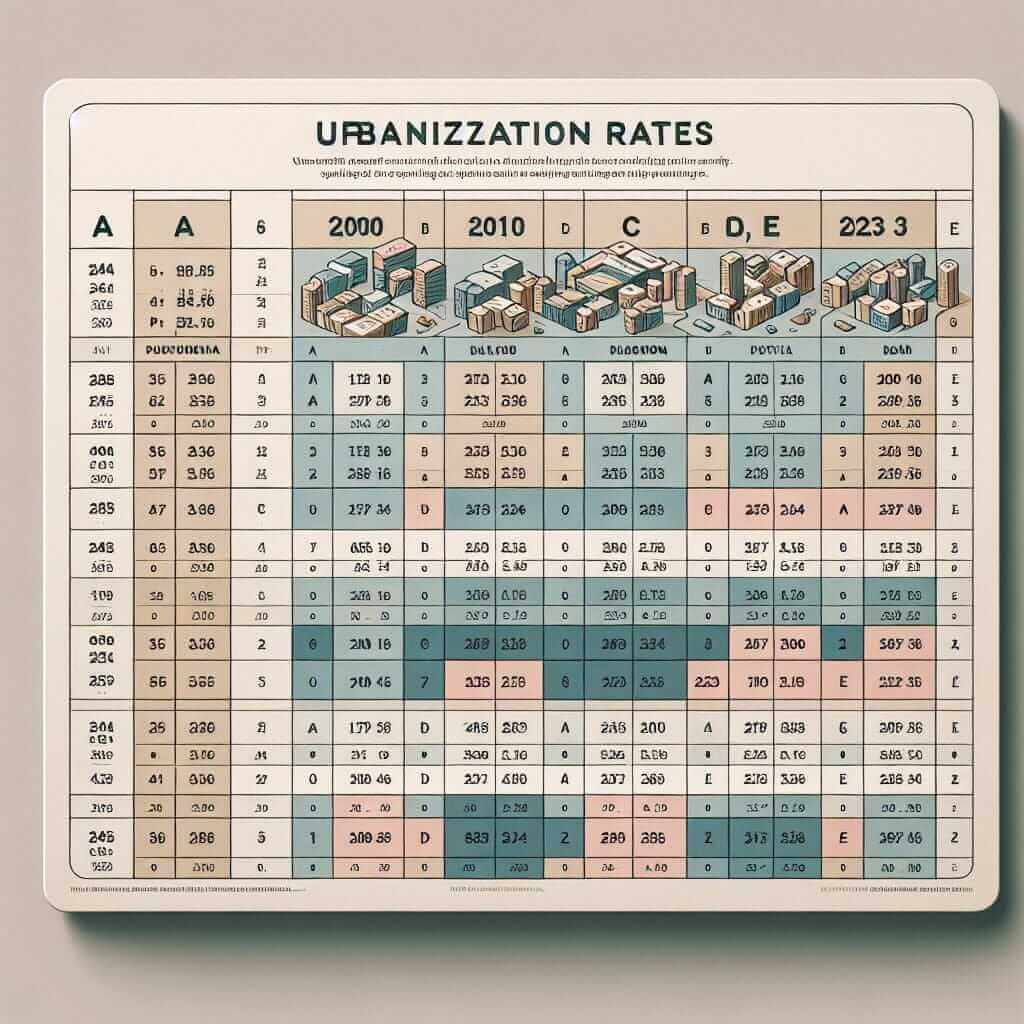Urbanization is a critical indicator of economic development and societal change. For IELTS Writing Task 1, where candidates are often required to summarize and explain given data, understanding how to compare levels of urbanization across different countries can be extremely beneficial. In this article, we’ll take a close look at how to approach this topic effectively.
Introduction
Understanding how to compare levels of urbanization is a frequently tested concept in IELTS Writing Task 1. The topic may appear in various forms such as bar charts, line graphs, tables, or maps. Below are three possible task prompts related to this theme:
- Task Prompt 1: The bar chart below shows the urbanization levels across three countries (Country A, Country B, and Country C) from 2000 to 2023.
- Task Prompt 2: The table below presents the percentage of the population living in urban areas in five different countries in the years 2000, 2010, and 2023.
- Task Prompt 3: The line graph below indicates the urbanization trends across several countries from 2000 to 2023.
For this article, we’ll select Task Prompt 2 for further analysis and sample writing.
Data Overview
Below is a table depicting the urbanization percentage in five countries across three different years:
| Country | 2000 | 2010 | 2023 |
|---|---|---|---|
| Country A | 45% | 55% | 70% |
| Country B | 60% | 65% | 80% |
| Country C | 35% | 50% | 62% |
| Country D | 50% | 60% | 75% |
| Country E | 40% | 55% | 68% |

Analyzing the Task
Task Analysis
The table presents data about the percentage of the population living in urban areas in five countries (Country A to Country E) over three distinct years: 2000, 2010, and 2023. The goal is to summarize the main features and make meaningful comparisons where relevant.
Sample Answer
Here is a sample answer based on the data provided:
The table illustrates the percentage of people living in urban areas in five different countries (Country A, Country B, Country C, Country D, and Country E) for the years 2000, 2010, and 2023.
Overall, all five countries showed a significant increase in urbanization levels over the given period. Country B had the highest urban population in both 2000 and 2023. In contrast, Country C, despite showing improvements, remained the least urbanized by 2023.
Specifically, the percentage of urban dwellers in Country A surged from 45% in 2000 to 70% in 2023. Country B also experienced a marked rise, from 60% in 2000 to 80% in 2023. Similarly, Country C saw an increase from 35% in 2000 to 62% in 2023.
Country D started with 50% of its population living in urban areas in 2000 and reached 75% by 2023. Lastly, urbanization in Country E grew from 40% in 2000 to 68% in 2023.
In summary, while all countries experienced an upward trend in urbanization, Country B consistently had the highest levels, and Country C the lowest, throughout the period.
Word count: 191
Important Tips for Writing
Vocabulary and Phrases
- Urbanization levels: Refers to the proportion of the population living in urban areas.
- Surge (verb): To increase rapidly.
- Marked rise (noun): A significant increase.
- Upward trend (noun): A general pattern of increase over time.
- Peak (verb): To reach the highest point.
Grammar Tips
- Use of tense: Since the data spans past, present, and future years, it is crucial to use the correct tenses. Typically, the simple past tense (increased, surged) is used for past data, and the present perfect tense (has increased) can be useful for highlighting changes up to the present time.
- Comparative structures: Use comparative and superlative forms to compare the data effectively (higher than, the highest, the least).
Noteworthy Vocabulary
- Urbanization (n.) [ˌɜːrbənaɪˈzeɪʃn] – The process of making an area more urban.
- Surge (v.) [ˈsɜːrdʒ] – To increase suddenly and sharply.
- Consistently (adv.) [kənˈsɪstəntli] – In a way that does not change.
- Marked (adj.) [mɑːrkt] – Clearly noticeable.
- Dwellers (n.) [ˈdwelərz] – People who live in a specific place.
Conclusion
To excel in this type of IELTS Writing Task 1, it is essential to effectively compare and summarize the given data while making meaningful comparisons. Focus on using appropriate vocabulary, verb tenses, and comparative structures to articulate your points clearly. Mastery of these skills can greatly aid in attaining a Band 7+ in your IELTS exam.